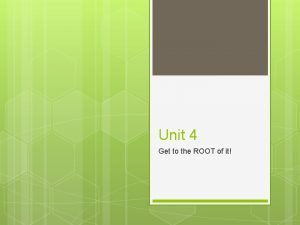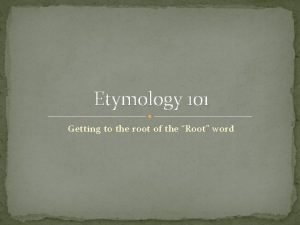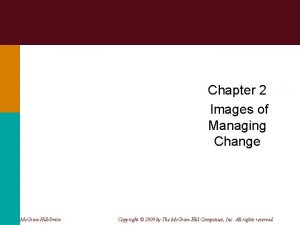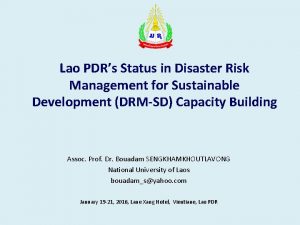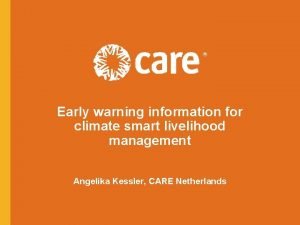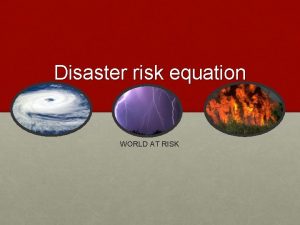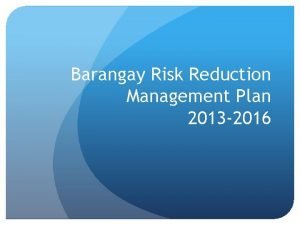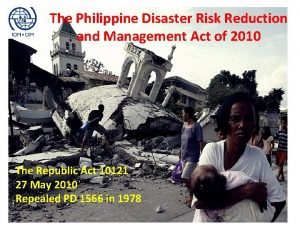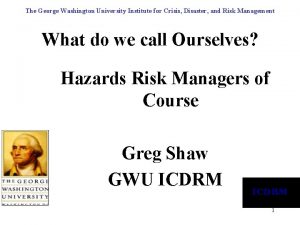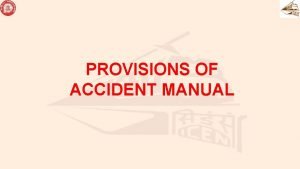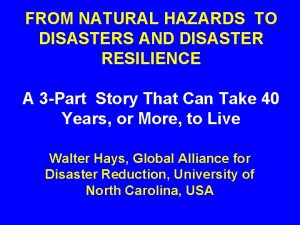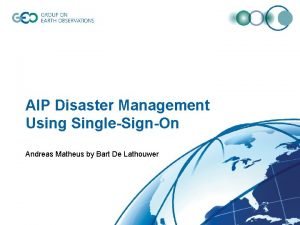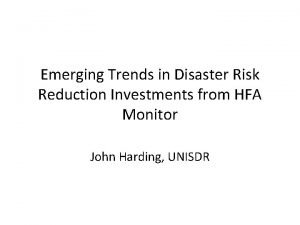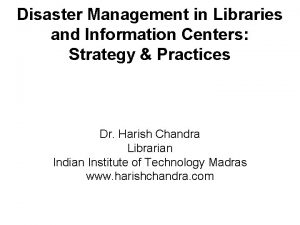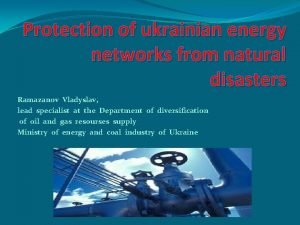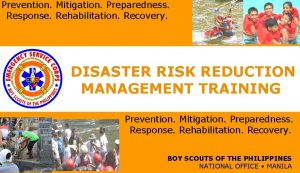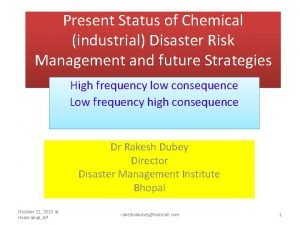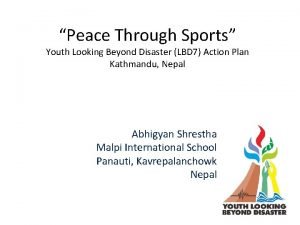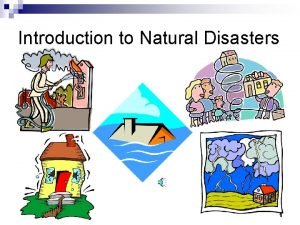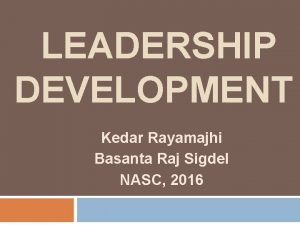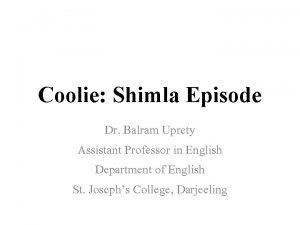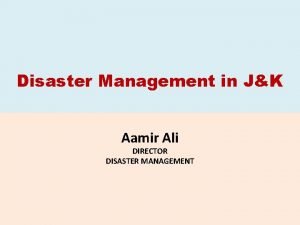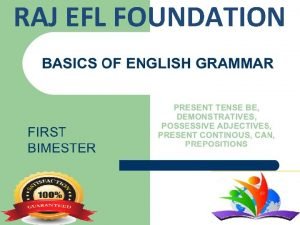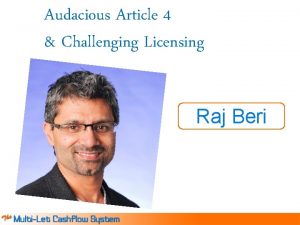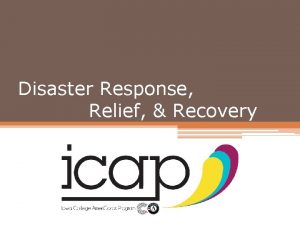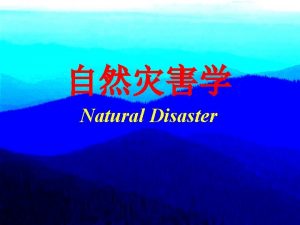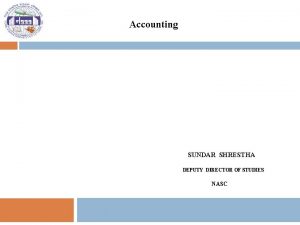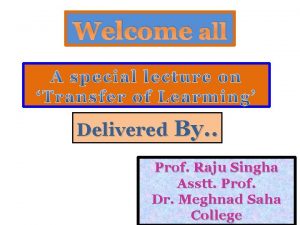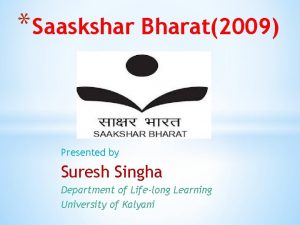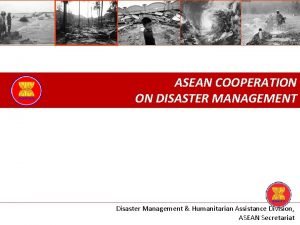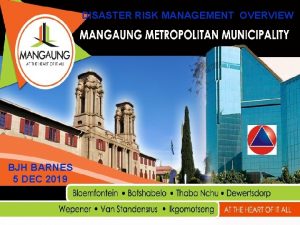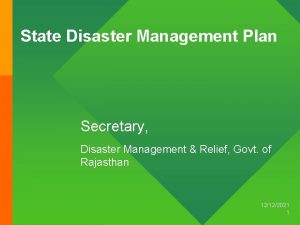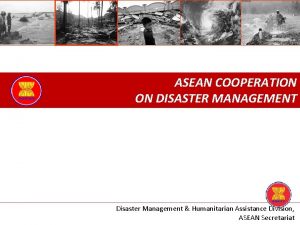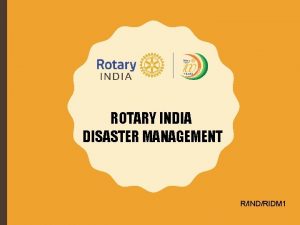Disaster Management DM Singha Raj Uprety Director NASC


























- Slides: 26

Disaster Management (DM) Singha Raj Uprety, Director : NASC 1

Learning Objectives At the end of this session we will be able to: • explain the conceptual underpinnings of disasters • understand the types, causes and scale of disasters; and • demonstrate basic skills to manage disasters. sruprety 2

Disaster? Loss or suffering caused either by a progressive or sudden calamity or misdeed which lead to the following situation: · total or partial loss of life or properties · disruptions to normal pattern of lives sruprety 3

Understanding disaster Basic elements required to call a disaster situation HAZARD OC CU R (Cause) EN C E VULNERABILITY (effect) = DISASTER sruprety 4

Example I d r a z a H Until the tre e falls caus ing losses of lif e property, it is just likeliho od of occur ring disaster ts c e j b o e l b a r e n l u V DISASTER 5

Example III Vulnerable Corrupt • Politicians • Planners • Policy makers Hazards sruprety 6

Understanding disaster Hazards may be: Natural Human-induced Complex Fire, air, land water related • Faulty plans, policies and infrast. • Misuse of scientific innovations • Abuse of natural resources • Ethical dishonesty • ………. . Poverty, environmental degradation, terrorism, social crimes, ……. sruprety 7

The human side of disaster sruprety 8

Understanding disaster Vulnerability may be: l a i c n Fina Ph c i m o n o Ec Politi cal l a c ysi l a i oc S Psychological Vulnerability is hazard dependent ! sruprety 9

Understanding disaster Disaster should not be taken for only the tragic situation brought about by certain incidents like natural flood, fire break, earthquake, storm etc. There are disasters prompted by human misdeeds in all sectors and in every walk of our life. (For instance, disasters are in construction field, urban settlements, consumption items, education, health, administration, religion, business, politics……) sruprety 10

New dimensions of disasters • Climate change • Terrorism • Market pollution (in quality and quantity of goods and services) • Conflicts for (land, water, forest, political ideology, social prestige, sensual enjoyment…. . ) sruprety 11

Understanding disaster Disaster levels and impacts Level • Global • National • Community • Individual Impacts Ultimate Secondary Primary sruprety 12

An automobile as it rolls out of the factory is a technological success. But when it is used as a means of transport this will pollute the biosphere thus to cause disasters. Likewise, human miseries brought about by atomic energy, war weaponries so on are glaring examples in producing mega-disasters. sruprety

Complexity in assessing the extent of loss or damage Earthquake or Flooding Unplanned Settlement Political Instability sruprety Destruction or damage of lives and properties Hazardous constructions, unsafe drinking water and sewage system, garbage pilings, traffic jams…… Loss of 1000 people plus the loss of Rs. 20 million worth. Loss from land, air, water and sound pollution, loss of beatitude, loss from uneconomic public utility services. Untold sufferings of people from the Conflict, insurgency, killings, deprivation of their homes, kidnapping, robbery, livelihoods, dignity, justice, human rights, democracy, mental peace etc. Which one is bigger loss ? Incidences Disaster situation Hypothetical Losses

We can calculate the direct losses caused by a firebreak, landslide, earthquake etc. But we cannot calculate the losses brought about by the morbidity, environmental degradation, misuse of harmful technology, absence of justice for human rights, denial of democracy, unproductive educational system and so on. Therefore, in many instances the losses propelled by human induced disasters prove far greater and vulnerable per se than the losses caused by natural disasters. All this necessarily demands a fresh definition of the term Disaster. sruprety

Understanding disaster Have you any question about understanding the concept of Disaster ? sruprety 16

Disaster management Disaster Management ? Disaster management is a continuous process of assessing the occurrences of different types of disasters in a given location and managing such disasters by way of formulating the following alternative plans: • Preparedness Plan • Mitigation Plan • Prevention Plan sruprety 17

Disaster management is possible Either by Controlling hazards Or by Controlling vulnerability Thru • Technical measures • Administrative measures sruprety 18

Why DM? Disaster management n avoid or minimize the probable losses of life and properties n follow the right path of development process. sruprety 19

Disaster management Disaster Formulate either • Preparedness or • Mitigation or • Prevention Plan DM Cycle Response • Rescue and relief • PDNA (post disaster need assessment • Sphere Standard Recovery Conduct DIA . t m v d t Selec projects sruprety Reconstruction Resettlement rehabilitation 20

Disaster Risk Reduction (DRR) At the World Conference on Disaster Reduction in Kobe, Japan, in 2005, the international community signed up to a 10 -year DRR strategy. • DRR is a systematic approach to identifying, assessing and reducing the risks of disasters. • It aims to reduce socio-economic vulnerabilities to disaster through multi-pronged approach. • It is generally means the application of policies, strategies and practices to minimize disaster risks and vulnerabilities throughout society for development. sruprety 21

ICT in DRM Information communication technology (ICT) is a means to inform vulnerable people in a quickest possible time in order to avoid or minimize the risk of their life and property. Application of ICT could be in: • pre-disaster stage • during disaster stage • post disaster stage All this will be further dealt in the upcoming sessions sruprety 22

Disaster management Remember that you are the disaster manager first of all of yourself then of your family, your community and of your nation. sruprety 23

My publications. 1. Guidelines for Improving Your Skills in Project Proposal Writing with LFA, Report Writing and Report Presentation Fifth and Enlarged Edition 2008, 2. Aaojana prastav Lekhan 2 nd Edition, 2009 3. Daibi Prokop Tatha Prokop Vayvasthapan, 2 nd edition 2066 B. S. (Disaster and Disaster Management: General Concept and Nepalese Context, in Nepali). 4. Fundamentals of Monitoring and Evaluation, 2 nd Edition 2008 5. People's Participation: Lesson for Better Planning published in 1999 by NASC. upretysr 24

Thanks for listening ! Untouched by ITC

Wish you all the best sruprety 26
 Prin ce se înmulțesc animalele
Prin ce se înmulțesc animalele Viv root word
Viv root word Respect root word
Respect root word Tg20 compliance sheet
Tg20 compliance sheet Tg scaffolding
Tg scaffolding 6 images of managing change
6 images of managing change Mean by conclusion
Mean by conclusion Early warning system in disaster management
Early warning system in disaster management Disaster risk equation example
Disaster risk equation example Records management disaster recovery plan
Records management disaster recovery plan What is disaster management
What is disaster management Disaster management centre sri lanka
Disaster management centre sri lanka Civil defence disaster management
Civil defence disaster management Bdrrm plan message
Bdrrm plan message Conclusion of disaster management
Conclusion of disaster management Philippine disaster reduction and management act
Philippine disaster reduction and management act Institute for crisis disaster and risk management
Institute for crisis disaster and risk management Inquiry report format
Inquiry report format 4 pillars of disaster management
4 pillars of disaster management Disaster management conclusion
Disaster management conclusion Emerging trends in disaster management
Emerging trends in disaster management Disaster management in libraries and information centres
Disaster management in libraries and information centres Conclusion on disaster management ppt
Conclusion on disaster management ppt National disaster risk reduction and management framework
National disaster risk reduction and management framework Chemical disaster management
Chemical disaster management Objective of disaster management
Objective of disaster management Disaster definitions
Disaster definitions

